The overall intent of this article is to consolidate major considerations when it comes to using Veeam Recovery Orchestrator to Recover from Backups.
Note: We will cover Backup Copies in another article, which is generally for recovery of VMs to another site during a critical site failure.
Key:
- VBR: Veeam Backup & Replication
- VRO: Veeam Recovery Orchestrator
Orchestrating recovery from Backups - Use-Case Overview:
- Below you will see a is common customer design example.
- Both sites are Active/Active with production virtual workloads being protected with Backup Jobs.
- (1) VBR server at Site-Z which is the DR location.
- Backup Proxy at each location.
- Backup Repository at each location.
- (1) vCenter at Site-Z and vSphere clusters at each location.
- Agent deployed protecting a physical workload.
- Our Veeam Transport (Data Mover) service is represented by a (M) icon here for these machines.
- Our Agent services are represented by a (A), although the Agent Backup and the one on VBR server is an Orchestrator Agent, they are different services.
- Backup Proxies:
- Virtual or Physical Proxy server transporting/source data from the Production vSphere clusters at each location.
- Backup Repositories:
- These are deployed at each location, generally a Windows/Linux server with direct attached storage, NFS/SMB or Storage appliance specific.
- RPO-1-A is the backup repository for Site-A VMs and Agent Backups.
- RPO-1-Z is the backup repository for Site-Z VMs.
- This is also often the Mount server, which is used to mount data for instant recovery with our vNFS protocol.
- You will also see Gateway mentioned here, this is specific for a certain backup repository which are unable to have the Data Mover installed locally. (IE: NFS/SMB)
- Note: This representation is acting a Direct Attached Storage on a Virtual Machine which has the Data Mover installed locally.
- Enterprise Manager and Veeam Recovery Orchestrator:
- For this example, we have these management overlay servers in the cloud, it's best when they are not on-prem if a site fails.
- Even better would be to have VBR (VBR-Z) also in the cloud, but for the sake of common configurations we will leave it at Site-Z.
- There are also considerations regarding Virtual Labs and testing that will come up in later articles I plan to develop.
Additional Site Recovery Considerations:
-
Backups are for recovering data from it’s own location and recovering it back to the same location. (Site-A → Site-A)
-
If Site-Z fails, VBR-Z is sitting on location, Veeam Recovery Orchestrator requires VBR to be online for recovery, as we need access to the policies and repositories.
-
There are ways around this, as previously mentioned having your VBR server in the cloud or witness location.
-
Replicating the VBR server with Veeam and doing a manual recovery of the VM at the other location.
-
Taking a configuration backup of Veeam, having a cold server in-place at Site-A, cloud or witness site to recover the VBR server during an orchestration event.
-
Note: That this failure will cause an increased RTO for a Site-Z failure, Site-A will not be impacted during a critical site failure as VBR will be online.
-
-
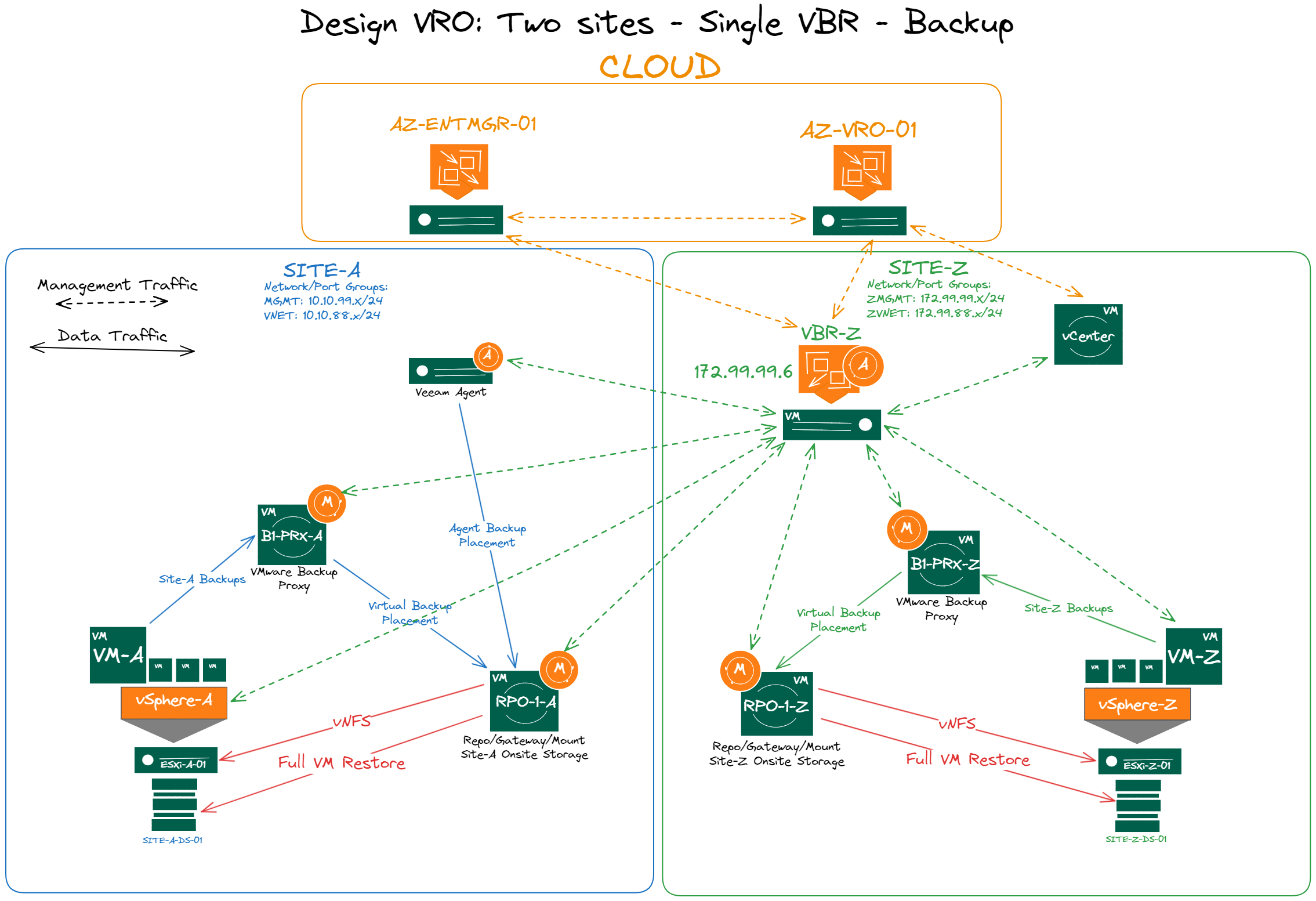
How do Restores from Backup work: (Referencing the above image)
Sourcing Data:
- VBR-Z has backup policies configured to protect both Site-A and Site-Z.
- B1-PRX-A and B1-PRX-B source data from Site-A and Site-Z respectively.
- Agent Backup has its own in-guest OS Agent installed that facilitates source and moving data to the onsite repository.
- The backup chains/data are stored on RPO-1-A and RPO-1-Z respectively.
Restoring Data:
- We have multiple ways to restore data in Veeam, the one we will focus on is VM Restore.
- VM Restore rehydrates the entire VM from the backup Repository with our Transport service into a ESXi Host and Datastore you specify during the recovery operation.
Veeam Backup Repository location: (Restore Source)
- One of the most important design aspects is the location of the backup data in which you plan to restore from.
- The best option here is a local repository for locally protected workloads.
- Note: Pulling from a Data Domain appliance which needs to rehydrate globally deduplicated data could add restore latency.
- The best option here is a local repository for locally protected workloads.
Veeam Recovery Orchestrator:
- It's important to note that for Veeam Recovery Orchestrator (VRO) we are utilizing components created and configured from the Veeam Backup & Replication interface.
- Veeam Recovery Orchestrator is an additional product and deployment on top of your existing Veeam Backup & Replication server, it connects to your Enterprise Manager and/or VBR instances and creates orchestration overlays.
- VRO Placement: If you have presence in the cloud, we would recommend that this be placed in the cloud or at a Witness location.
- Additional considerations: Veeam University (VU) https://veeam.looop.co/topic/834185
- VMware Tagging: A popular but very important aspect of our Veeam product when grouping and categorizing workloads to protect and in this case grouping of servers for restoration.
- With Veeam Recovery Orchestrator mapping and grouping your workloads for orchestration, it's best practice to-do so with VMware Tags.
Veeam Recovery Orchestrator Core Components:
- Recovery Locations: We create and utilize these in VRO to pinpoint the resources we are going to utilizing during a recovery event. Some of the selections include source data and placement of converted workloads. (Compute, Storage, Networking and Re-IP Rules.)
- Recovery Plans: A recovery plan is where we select the workloads we will orchestrate and the Recovery Location in which those workloads will be recovered to.
How to Configure VRO for Orchestration of a Test VM in Site-A:
- Below I am going to walk you through how to configure an example recovery of a Site-A VM being recovered back to the same site.
- We will configure VMware Tags, Recovery Locations, and Recovery Plans.
-
Note: Agent Recovery, you can't use VMware Tags but you can select Agent Backup policies protecting that VM instead.
-
Creating VMware Tags:
- We need to create at a minimum (3) VMware tags for each Site on our vCenters or single vCenter if it manages both sites.
- These Tags will be used to define Compute and Storage locations for the entire VM restore of a Virtual or Agent workloads.
- Create Tags:
- In vCenter you will want to go to your menu in the upper left-hand corner and then select (Tags & Custom Attributes) from the list.
- Create a new Category and name it VRO or something similar.
- Create (3) New Tags for each location and associate them to the VRO Category you created. (IE: VRO_COMPUTE_SITE-A, VRO_STORAGE_SITE-A, and VRO_TESTVM_SITE-A)
- Reference: I would link a VMware article but that might change, so google "What are VMware Tags and How to use them"
- Associate Tags:
- Go back to Inventory on the upper left-hand menu in vCenter and find your Compute and Storage to Tag.
- Associate the compute Tag you created to an ESXi host or Cluster.
- Associate the Storage Tag you created to a Datastore or Cluster.
- Associate the TESTVM Tag to a Test server that you have protected with a Backup Job on the VBR server.
- Updating VRO Inventory:
- Use the Tags created above, if you don't see them in the VRO inventory, login to the Veeam One Web client (https://VROVM:1239/) and run a rescan from the configuration page.
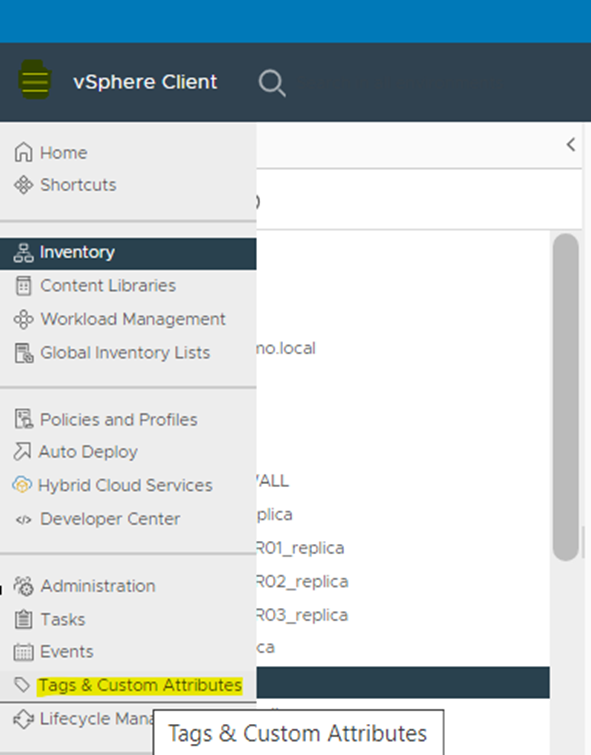
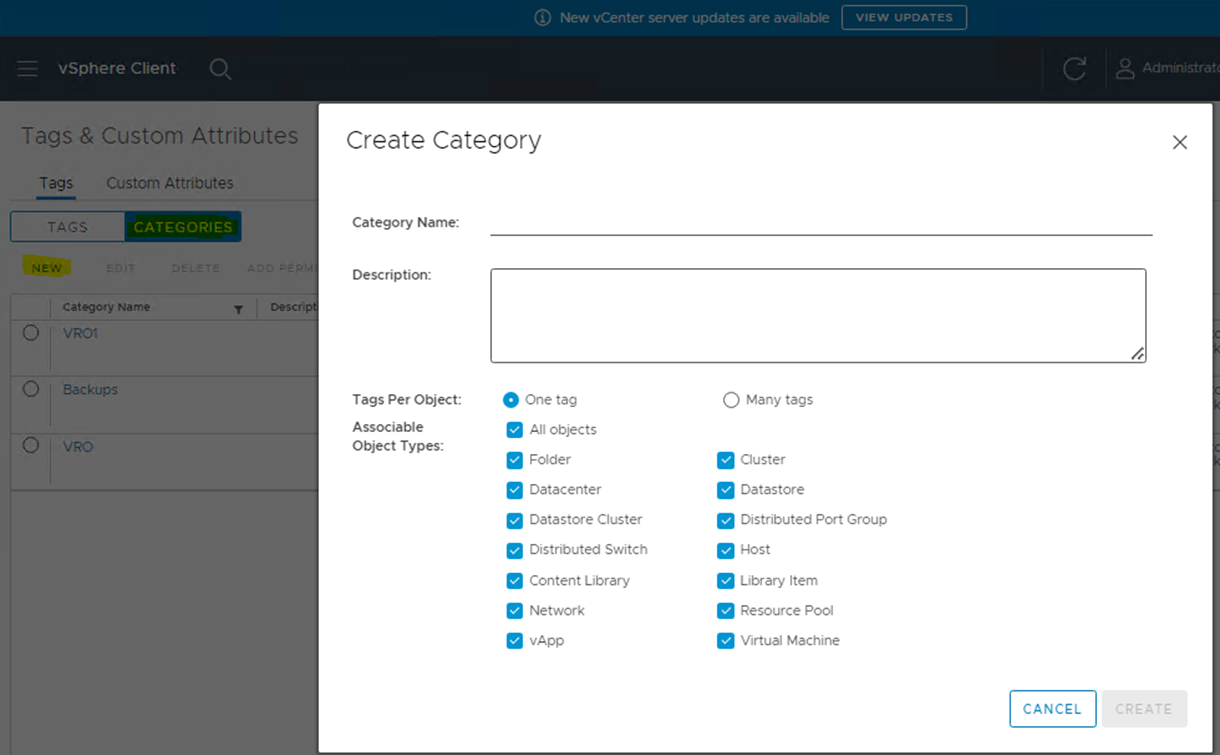
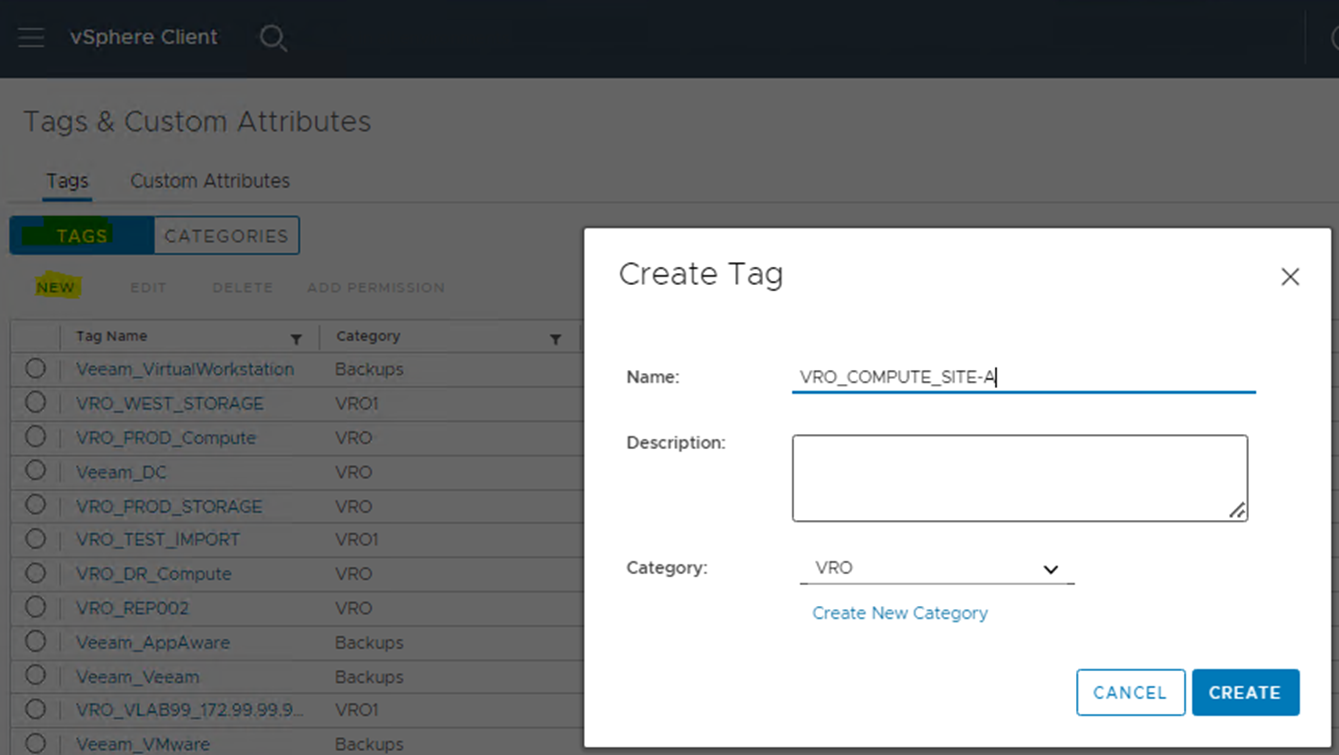
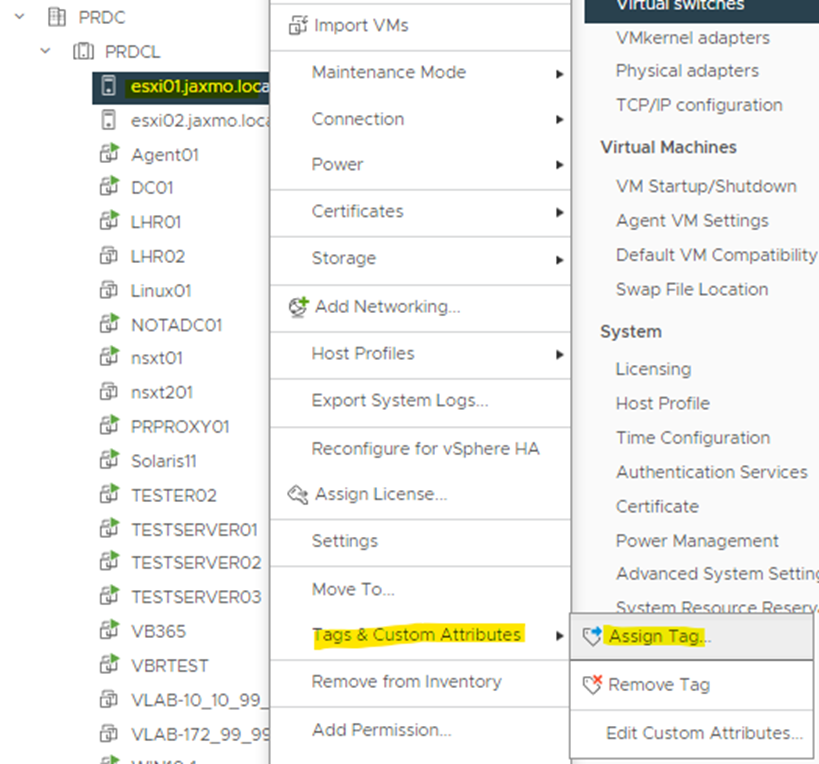
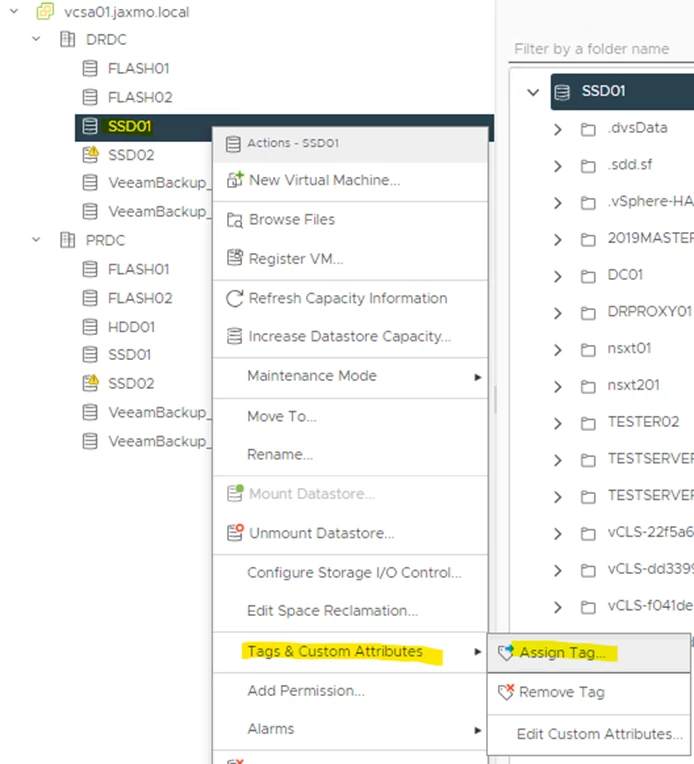
Creating Recovery Locations:
- Now that we've identified the Compute and Storage locations, we can now use these VMware Tags in our Recovery Location in Veeam Recovery Orchestrator.
- Login to your VRO server: (https://VROVM:9898), click the gear icon in the upper right-hand corner to enter Config/Administration mode.
- On the left-hand side in the Navigation pane click (Recovery Locations), then click (Add).
- Once in the New Recovery Location Wizard fill out the following:
- Select (VMware) as the Location Type.
- Give a Location Name: (IE: VRO_RECOVERY_LOCATION_SITE-A)
- Recovery Options: Select (Recovery Agent Backups) and/or (Recover VM Backups) as needed.
- Compute Resources: Select the (VRO_COMPUTE_SITE-A) Tag we created earlier.
- Storage Resource: Select the (VRO_STORAGE_SITE-A) Tag we created earlier.
- Storage Options: Don't select backup copies, this is for cross site recovery. (%80 of Capacity is fine)
- Agent / VM Networks: This will map source VMware Network/Port Groups, back to the Source or different VMware Network/Port Groups as needed.
- If you are restoring back to the same site and same network through VRO in a use-case such as ransomware.
- Note: We capture the Port Group the VM is on during the backup which is stored in the .VMX file.
- Re-IP Rules: This is only required if you are restoring to a different destination Port Group/network.
- Data Sovereignty: This is defined in VBR and can be enforced here in VRO If needed.
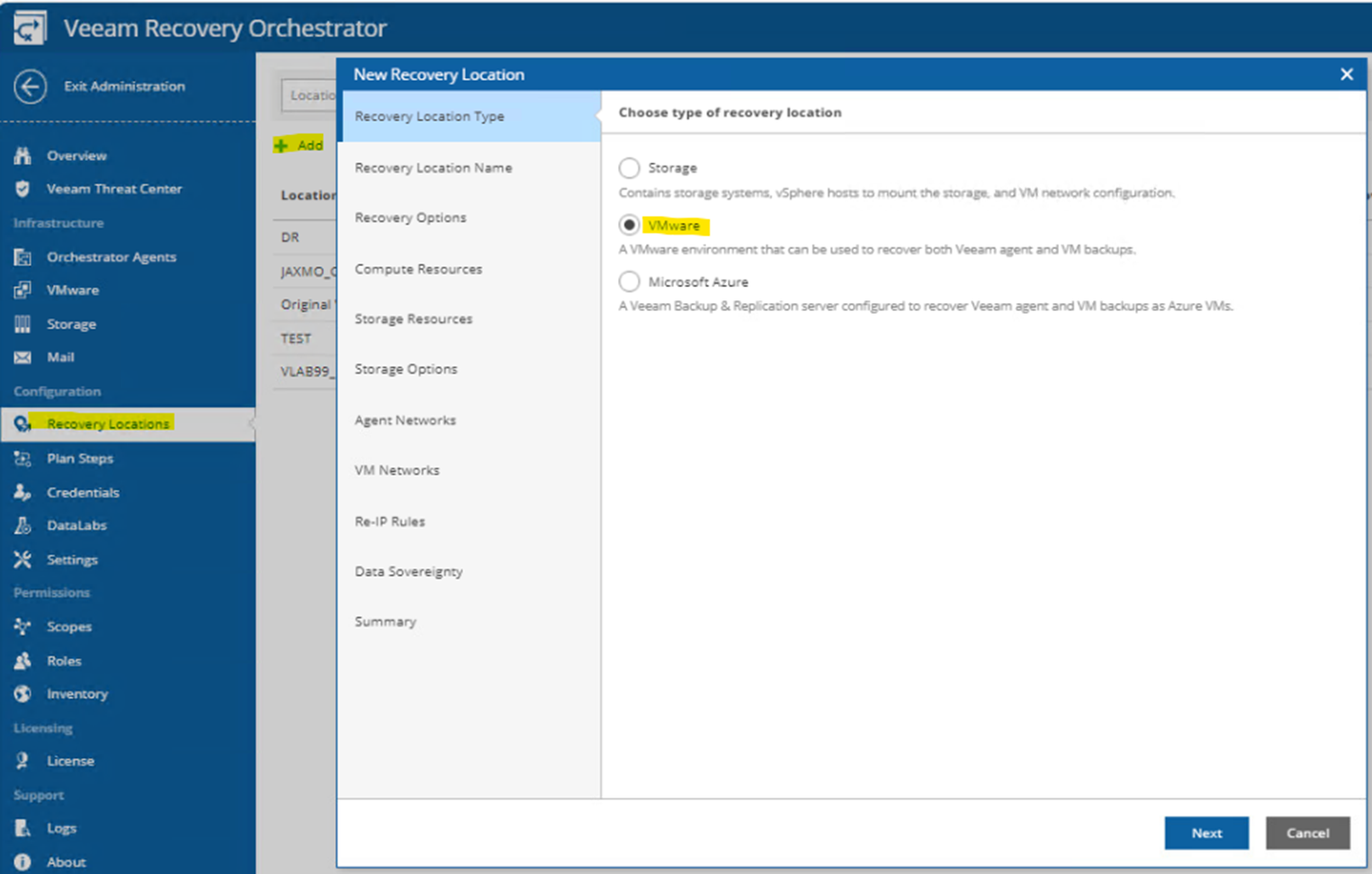
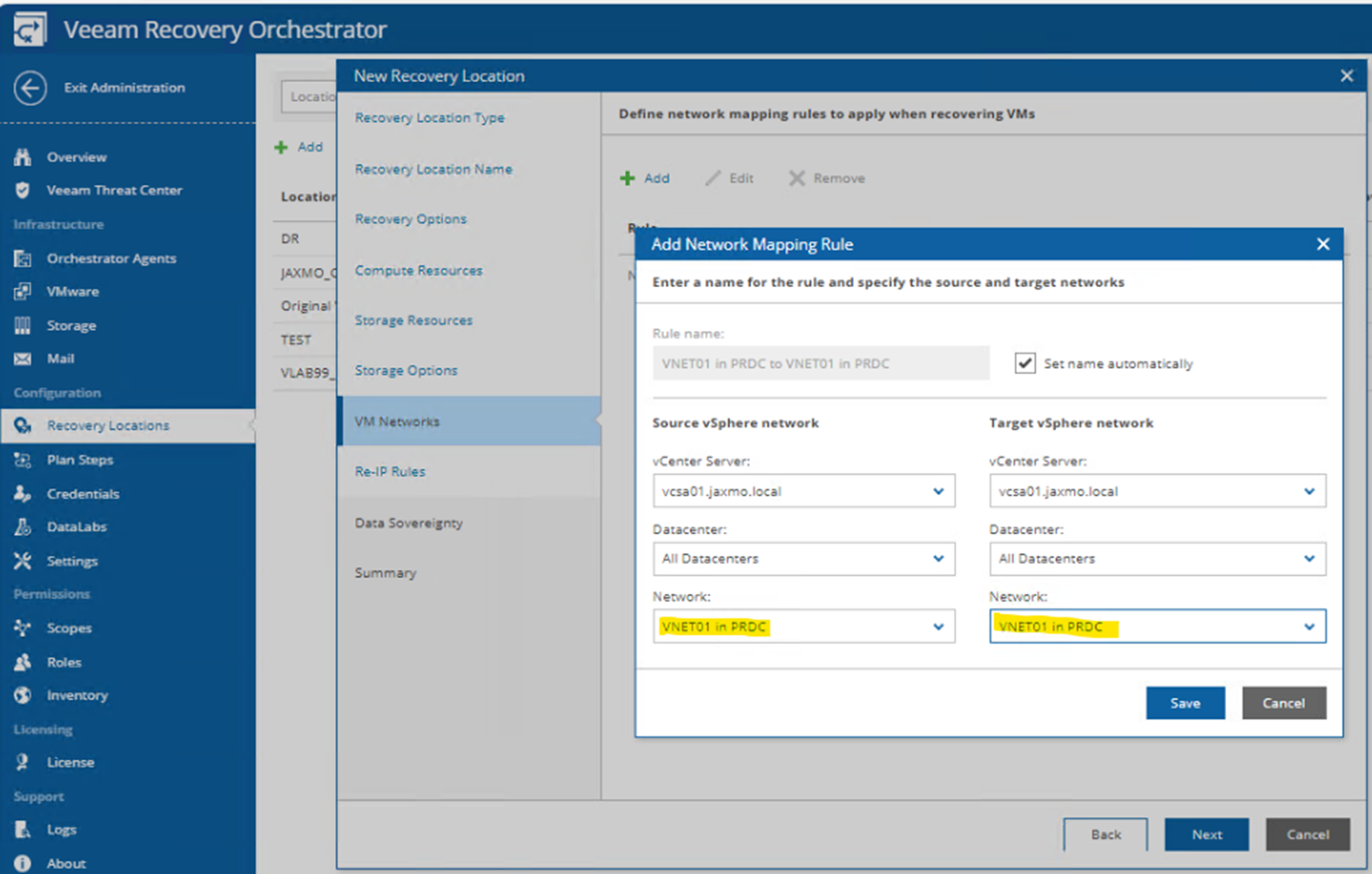
Creating Recovery Plans:
- Now that we've created a Recovery Location, we will create a Recovery Plan that will associate to our newly created Recovery Location.
- Exit Administrator by clicking (Exit Administration) in the upper lefthand corner.
- On the left-hand side in the Navigation pane click (Recovery Plans), select (Manage), and select (New)
- Once in the New Restore Plan Wizard fill out the following:
- Give a Recovery Plan Name: (IE: VRO_RECOVERY_PLAN_SITE-A)
- Plan Type: Select (Restore) plan type.
- Recovery Location: Select the (IE: VRO_RECOVERY_LOCATION_SITE-A) Recovery Location that we created.
- Inventory Groups: This is where we can select the (VRO_TESTVM_SITE-A) Tag we created.
- Or Agent Backup Policy for Agent testing.
- Note: You can also select the Backup Job you have created as well, tags are best for scaled out deployments or single VM testing.
- VM Recovery Options: Choose defaults here.
- VM Steps: Add Ping Test
- Protect Inventory Groups: Only for reprotection of the Virtual Machine after a commit failover.
- RTO&RPO: This simply validates whether the protected workloads are achieving these marks for the associated Backup Plan.
- Report Template: Default
- Report Scheduling: Default
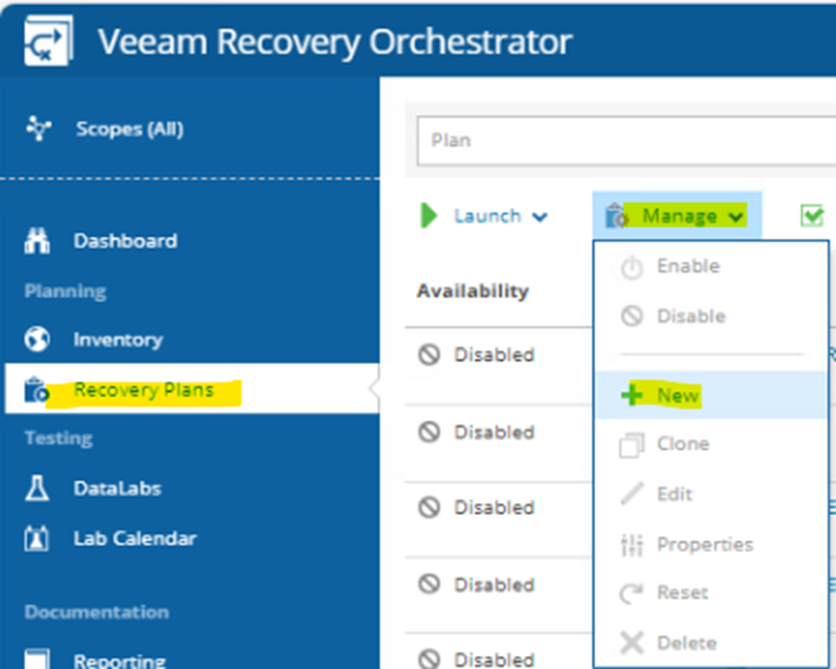
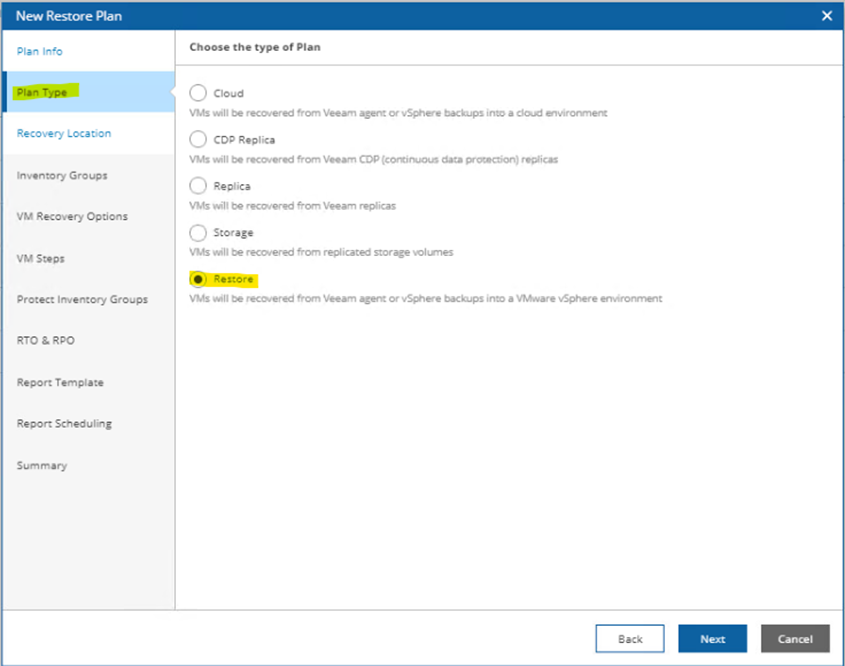
Closing:
- Once you have this all created you are ready to run a live recovery of a Virtual Machine you backed up with Veeam Backup & Replication.
- Note: This is a live recovery and should be taken at your own risk, Veeam is not responsible for any production outages or loss of data for your recovery configurations and actions.
Recovery_Workbook: https://docs.google.com/spreadsheets/d/1qyZHWLFMg64q9CfQ3Ohnv1gRWNzT9LSzpW7L8JKkCEQ/edit?usp=sharing


